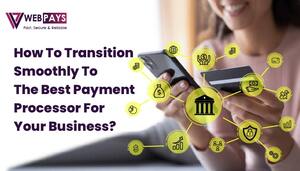How To Transition Smoothly To The Best Payment Processor For Your Business?
الجسم
Choosing the right payment processor is crucial for any business. With a plethora of options available, finding the best payment processing company for your needs can be overwhelming. Whether you’re a startup looking to set up your payment infrastructure or an established business considering a switch, ensuring a smooth transition to the best payment processor is essential for maintaining operational efficiency and enhancing customer satisfaction. In this blog, we’ll guide you through the process of transitioning smoothly to the best payment processor for your business, drawing on the latest industry statistics and best practices.
Why Choosing the Right Payment Processor Matters
The payment processor you choose impacts more than just how you handle transactions. It affects your cash flow, customer experience, and even your bottom line. According to a report by the Nilson Report, global card payments exceeded $33 trillion in 2022, and the trend is expected to continue growing. This underscores the importance of selecting the best payment processor that can handle a high volume of transactions seamlessly.
Key Factors To Consider When Choosing a Payment Processor
1. Transaction Fees and Costs
- Consideration: Transaction fees can significantly impact your profitability. These fees vary between processors and can include per-transaction fees, monthly fees, and additional costs for features like fraud protection or chargebacks.
- Tip: Analyze your transaction volume and average transaction size to estimate costs with different processors. Look for transparent pricing models and avoid processors with hidden fees. The best payment processing companies offer clear, competitive pricing tailored to your business needs.
2. Integration Capabilities
- Consideration: The payment processor you choose should integrate smoothly with your existing systems, such as your e-commerce platform, point of sale (POS) system, and accounting software. Poor integration can lead to manual errors and operational inefficiencies.
- Tip: Ensure the processor provides APIs or pre-built integrations for the software you already use. The best payment processors offer flexible integration options that streamline your workflow and reduce administrative burdens.
3. Security Features
- Consideration: Payment security is paramount, as data breaches can lead to significant financial and reputational damage. Look for processors that offer advanced security features like encryption, tokenization, and fraud detection.
- Tip: Choose processors compliant with Payment Card Industry Data Security Standard (PCI DSS) regulations. This ensures they meet stringent security standards to protect sensitive payment information.
4. Customer Support
- Consideration: Reliable customer support is crucial for resolving issues quickly and minimizing downtime. Poor customer service can lead to delays in resolving payment disputes or technical problems.
- Tip: Opt for processors with a reputation for excellent customer support. Look for features like 24/7 support, multiple contact methods (phone, chat, email), and a dedicated account manager.
5. Ease of Use
- Consideration: A user-friendly interface can simplify payment processing for your staff and improve the customer experience. Complex systems with a steep learning curve can lead to operational inefficiencies.
- Tip: Test the processor’s user interface and check for ease of use. The best payment processors offer intuitive dashboards and easy-to-navigate features that enhance overall user experience.
Steps For Smooth Transition To The Best Payment Processor
1. Evaluate Your Current System:
Before making any changes, assess your existing payment processing system. Identify its strengths and weaknesses, and determine what features or capabilities are lacking. This evaluation will help you define your requirements for a new processor.
Action to take: Create a list of features you need, such as mobile payment capabilities, recurring billing, or multi-currency support. This will serve as a benchmark for evaluating potential processors.
2. Research and Compare Payment Processors
Research different payment processors to find the best fit for your business. Compare their fees, features, integration capabilities, and customer support. Utilize resources like industry reviews, comparison websites, and customer testimonials to gather insights.
Action to take: Request demonstrations or trials from shortlisted processors to assess their functionality firsthand. This hands-on approach will help you make an informed decision.
3. Plan Your Transition
A well-planned transition is key to minimizing disruptions. Develop a detailed plan outlining the steps for switching processors, including data migration, system integration, and staff training.
Action to take: Create a timeline for the transition, and communicate it to all relevant stakeholders. Ensure that you have contingency plans in place to address any unexpected issues that may arise during the switch.
4. Migrate Data and Test the New System
Data migration is a critical step in transitioning to a new payment processor. Ensure that all transaction data, customer information, and payment settings are accurately transferred to the new system.
Action to take: Conduct thorough testing of the new system before going live. Test all functionalities, including transaction processing, reporting, and integration with other systems, to ensure everything works as expected.
5. Train Your Team
Ensure that your staff is well-trained on the new payment processing system. Provide comprehensive training on its features, functionality, and troubleshooting procedures.
Action to take: Arrange training sessions and create user guides or documentation for reference. Offer ongoing support to help your team adapt to the new system and address any questions or concerns.
6. Monitor and Optimize
After transitioning to the new payment processor, closely monitor its performance and gather feedback from your team and customers. Use this feedback to make any necessary adjustments and optimize the system for better performance.
Action to take: Set up regular check-ins to review the processor’s performance and address any issues promptly. Continuously evaluate its impact on your business operations and make improvements as needed.
Best Practices For Choosing the Best Payment Processor
- Stay Informed: Keep abreast of industry trends and emerging technologies in payment processing. This knowledge will help you make informed decisions and stay competitive.
- Seek Recommendations: Consult with industry peers or business advisors who can provide insights and recommendations based on their experiences with different payment processors.
- Negotiate Terms: Don’t hesitate to negotiate terms and pricing with payment processors. Many are willing to offer better rates or customized solutions based on your business needs.
Conclusion
Transitioning to the best payment processor can greatly improve your efficiency, security, and customer satisfaction. By assessing your needs, exploring options, and planning carefully, you can ensure a smooth switch. The right processor is a key partner in your business’s growth. At WebPays, we specialize in payment processing solutions. Whether optimizing your current system or making a full switch, our expertise, and tailored solutions are here to help. Contact us to learn how we can support your payment processing needs.












تعليقات